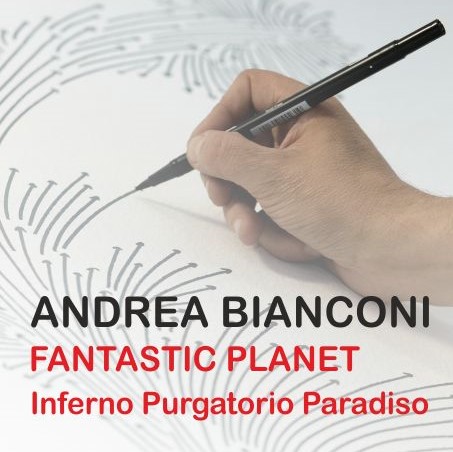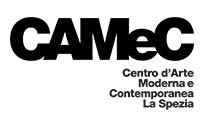
Andrea Bianconi
An allegorical journey in the footsteps of Dante through the three worlds, to discover the place of origin of the imagination which “moves the sun and the other stars”
From 22 June to 30 September 2018, La Spezia – CAMeC Centro Arte Moderna e Contemporanea (Centre of Modern and Contemporary Art) presents Fantastic Planet. Hell, Purgatory and Paradise byAndrea Bianconi. In this exhibition the artist’s intention is torepresent an inner allegorical journey which each visitor will be called upon to make during their visit. In the exhibition “αlfaβeta” (at the Nuova Galleria Moroni of Milan until 6 July) Andrea Bianconiobsessively asks himself some questions within a restricted space: “Does a Fantastic Planet exist?”, “Where can it exist?”, “What is it exactly?”; with Fantastic Planet. Hell Purgatory and Paradise”on the other hand, the artist presents the mimesis of an inner journey. While the Milan exhibition has offered some possible answers to these questions, imagining the fantastic planet as being inside ourselves (in the case of the cage with the mirror), outside ourselves (in the case of the arrows coming out of all points of a flat surface), or as being identifiable after the almost obsessive repetition of certain words (“Fantastic Planet”), the La Spezia exhibition is the development, the evolution of Bianconi’s work of investigation.
Everything revolves around the idea of the journey, including the physical journey that the visitor makes through the various areas inside the museum. The source of inspiration is the journey described by Dante Alighieri through the three worlds of the Afterlife: Hell, Purgatory and Paradise. Like the journey made by the Great Poet, which has a double possible interpretation, both literal and allegorical, Bianconi’s “journey” too has a purpose: while for Dante it is purification, for Bianconi it is the discovery of the origin of the imagination, that element which produces and feeds the very desire to undertake a journey. At the end of the journey, spectators find themselves in front of a large wall with a hypothetical landscape drawn on it, consisting of arrows which indicate that Hell, Purgatory and Paradise are just about everywhere, immediately reachable from any random direction, and visitable even in the space of a single day.
Hell is not “loudly proclaimed”; there are arrows drawn on black squares which are visible only from close up, as if to make a slightly ironic, playful comment on the presence/absence of these directions. The cage with the mirror, the symbol of introspection and reflection which is very dear to Bianconi, could not help but be accommodated in this “world” where questions, conflicts and sudden realisations are an automatic part of the agenda.
The artist also makes a further journey via a musical medley which narrates the stages and particular moments his life in a kind of sensorial exercise, a way of reliving his memories through pieces of music which are linked to them; a continuum (harmonious or not we do not know) which is able to generate or revive all types of emotion, a hell which is black but which is to all extents and purposes a potential Purgatory or Paradise. The suspended, empty cages are instead the symbol of Purgatory, which is in fact the suspended place, the place of transition, where we do not know what exactly will happen. This is the only “world” in which drawings are present and where the dominant colour is grey.
Bianconi’s Paradise is instead the place of creation, where white and harmony dominate; this is represented on a canvasfull of arrows, many of which look like flowers. While for this work the artist has been extremely meticulous, giving it a formal perfection, for the other one, again showing arrows and present in the same room, he has instead chosen a random technique, drawing with his eyes closed in order to create and emphasise the concept pf intrinsic perfection and connected to that of Paradise. Each work present in Paradise is already perfect in itself, since it is created in this “world”, even if there is no attention to detail in them and they are made without the necessary mastery. We reach the final destination of the journey in a room opposite these three, but very close to that of Paradise, completely black and darkened. Here the motif of the arrow becomes a symbol of salvation in a light installation. Arrowsare the indication whereby the spectator moves towards a new journey, which each person hopes will end with the view of the stars, just as Dante writes when he comes out of Inferno: “Where we came forth and once more saw the stars”.
End of the journey. Along the stairs of the Centro as you go up, a black man symbolically holds a bunch of arrows in his hands. It is Andrea Bianconi’s vision of the world, in which every person forges their own destiny, since they have at their disposal all the possible choices/directions. In the words of the curator Vittoria Coen: “an itinerary, a journey, which becomes cathartic, towards a symbolic elevation of the spirit”.
Born in Arzignano (Vicenza) in 1974, Andrea Bianconi lives and works in the United States and Italy. He has recently exhibited at the MSK Museum of Fine Arts of Ghent (Belgium), and participated in the 5thMoscow Biennale with a public performance in the Red Square, the Kremlin and the Manegeand with a wall installation at the Manege. He has created a work at the Italian Embassy in Washington D.C. for the 150th anniversary of the Unity of Italy. He has exhibited at the Boghossian Foundation, Brussels; Museu do MeioAmbiente, Rio de Janeiro; Centro del Carmen, Valencia; Matadero, Madrid; Film Society Lincoln Center, New York; Maraya Art Centre, Sharjah, United Arab Emirates; Swiss Architecture Museum (SAM), Basel; KunsthalCharlottenburg, Copenhagen; ISCP, Brooklyn, NY; Palazzo Reale, Milan; VestfossenKunstlaboratorium, Norway; Furini Arte Contemporanea, Rome; Barbara Davis Gallery, Houston, Texas. He has givennumerous public art performances such as Summer Night Series, Union Square NYC; Italian Cultural Institute, NYC; Postcard People, Hudson Valley Center for Contemporary Art (HVCCA), NY; The Chinese Umbrella Hat Project (Part I), Wujiang Rd West Nanjing Rd, Shanghai, China and (Part II) Piazza San Marco, Venice. In 2011 Charta published his first monograph; in 2012 Cura. Books published his first artist’s book “ROMANCE” and in 2013 the second one entitled “FABLE”. Both are part of the MoMA collection, NYC. In 2016 SilvanaEditoriale published the monograph about the artist’s 10 years of performance art, “Andrea Bianconi Performance 2006-2016”. In 2017 AmCCollezione Coppola published “SOLO”, a monograph with an interview by Catherine De Zegher. In the same year at the Galleria Bianconi of Milan he held the exhibition “Partiture Visive” (“Visual Scores”) curated by Vittoria Coen, and the exhibition entitled P-Art-Y at Palazzo Bernaroli in Bologna. In 2018 he exhibited at the Archiginnasio of Bologna. Recently he has presented a performance in Davos (Switzerland), an event curated by Oliver OrestTschirky, during the 48th edition of the World Economic Forum; at the VestfossenKunstlaboratorium (Norway); an exhibition with performance at the Galleria Alessandro BagnaiinFoianodellaChiana (Arezzo); at the Nuova Galleria Morone (Milan); and a performance in Palermo in the crypt of the church of Santa Maria del Piliere.
The Mayor, Pierluigi Peracchini
The Councillor for Culture, Paolo Asti
and produced by
CAMeC centro arte moderna e contemporanea
(Centre of Modern and Contemporary Art)
Director of Museums and Cultural Services, MarziaRatti
INFORMATION AND CONTACTS
Title: Andrea Bianconi. Fantastic Planet. Hell Purgatory Paradise
Curated by: Vittoria Coen
Technical-scientific coordination: Eleonora Acerbi, Cinzia Compalati, Cristiana Maucci
Tel. +39 0187 727530 | email: camec@comune.sp.it
For information: Tel. +39 0187 727530, camec@comune.sp.it, https://camec.comune.laspezia.it
COMMUNICATIONS
Andrea Bianconi
press office: Maria Grazia Vernuccio | Tel. +39 3351282864 | mariagrazia.vernuccio@mgvcommunication.it
Municipality of La Spezia: Luca Della Torre | Tel. +39 0187 727324 | ufficiostampa@comune.sp.it
